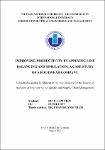| dc.description.abstract | This study examines a local brand footwear company in Vietnam facing productivity
issues, particularly in the stitching line section due to its highly manual nature. Despite
past attempts at line balancing, bottleneck areas persist, hindering optimal productivity.
The study aims to resolve these bottlenecks and improve productivity by implementing
the ECRS method, integrated with the Yamazumi chart for bottleneck identification.
Additionally, the ARENA Simulation Software is used to compare improvement results.
The result analysis involves comparing future state Yamazumi chart outcomes with
those from the simulation model, using Comparison between the two System Designs
for Common Random Numbers (CRN) to identify discrepancies. Based on the ARENA
Simulation report, suggestions are made to adjust processing time in bottleneck areas to
observe their impact on the current system. The research concludes with comprehensive
recommendations and conclusions derived from the model's findings | en_US |


